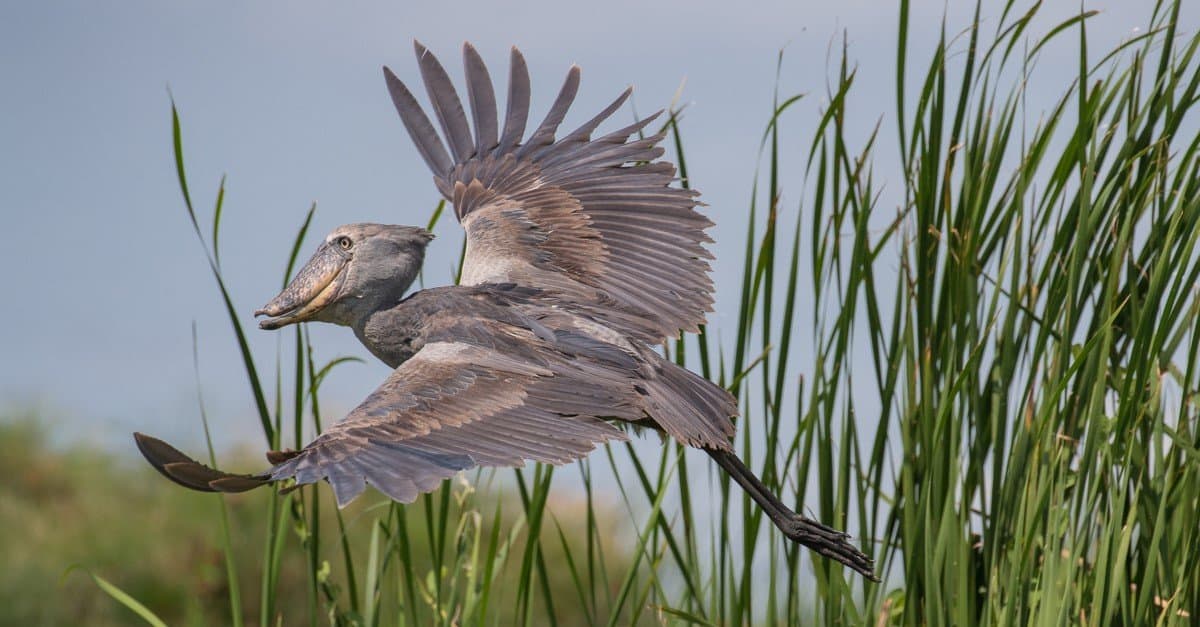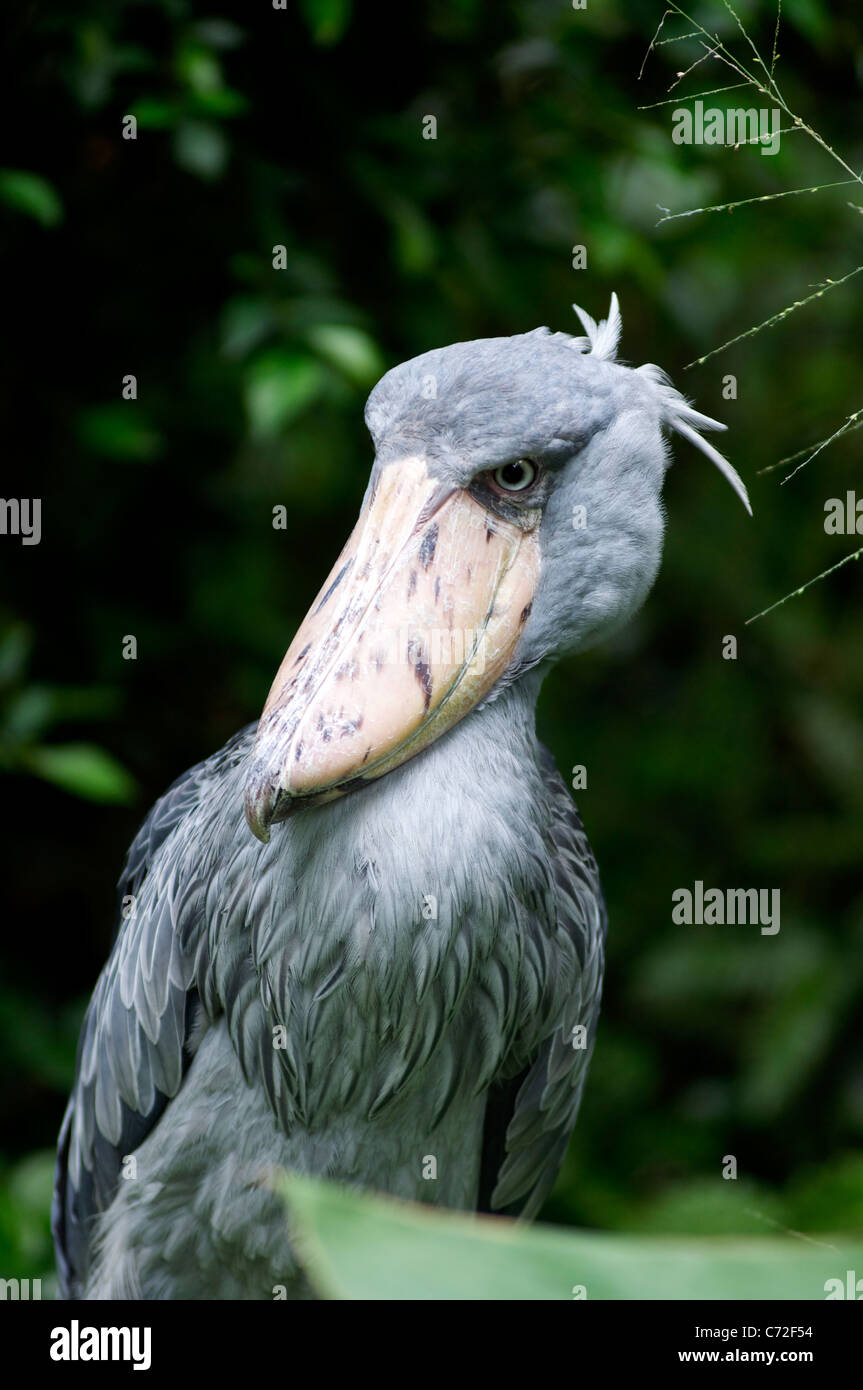
Prey detection seems to be visual, but hearing may prove useful as well. The shoebill holds its bill vertically downward, out of the way of its binocular vision. Shoebills are “stand-and-wait” or “wade-and-walk-slowly” hunters.

Less common are young water birds and crocodiles. Lungfish, catfish, and tilapia are common food items, as well as water snakes, frogs, monitor lizards, and young turtles. Standing stock still, once it detects a fish, the shoebill is all in-swiftly collapsing its entire body weight at the prey item, with its bill taking the brunt of the impact. The shoebill’s sturdy, reinforced bill is crucial, given the bird’s hunting technique. Like pelicans and storks, shoebills also partake in gular fluttering to release excess heat. Staying cool entails urohidrosis, meaning urinating on its legs, and the inevitable evaporation has a “chilling” effect on the bird. It spends a great deal of time motionless-it can be difficult to tell if the bird is fishing or resting! It tends to be slow moving, except in the moment of collapsing on its prey with lightning speed. While it may perch or roost in trees, it is more often in or near water. What’cha doin? Shoebills are diurnal, and only occasionally hunt at night if the moonlight is bright enough. Deeper waters take longer to dry out and are avoided by predators and returning farmers, with their livestock and fires. They tend to use deeper areas of swamps, tucked into tall, dense vegetation, away from disturbances. Shoebills nest atop floating vegetation and gather plant material from surrounding areas to construct their nest. While they tend to steer clear of human contact (rightfully so), the main goal is to be invisible to its prey below the surface. Waters with low oxygen content are favored hangouts, as fish need to surface more often, and possibly meet the gaping maw of a hungry shoebill. Its “collapsing” fishing technique is not effective in deep water, so this bird sticks to the shallows, mostly. In Uganda, it is found along marshy edges of lakes, in areas grown over with reeds, papyrus, and grasses, for cover and nest material. Shoebills stake out overspill areas, where water is moving slowly past toward lakes, carrying with it lots of delicious fish. The shoebill favors the vast papyrus swamps of the Sudd, in northern East Africa. It has long legs and long toes, which also help it traverse sodden, marshy habitats. It’s wings help it keep its balance when clambering over shifting, wet vegetation. The shoebill’s wings are well suited for soaring they are strong enough to enable the bird to lift off near vertically, though it requires a powerful leap and a few heavy wing beats to catch a thermal.

The upper mandible ends in a sharp nail, which helps shish-kabab slippery prey. Its unusual large, splotchy bill has sharp edges, which help in the swift decapitation of prey, and also in separating out vegetation that may be grabbed with the fish. It has a small, shaggy nuchal crest and piercing eyes that are yellowish or grayish-white. The belly is white, with some elongated feathers on the breast, with dark, contrasting shafts. A soothing combination of blue-gray, dark gray, and slate color make up most of its plumage. Shoebills are large-bodied, sturdy birds. Further muddying the waters, the shoebill’s mighty skull resembles that of pelicans, but that could be due to convergent evolution and both birds’ violent method of fishing (see Diet section below).īig bird. It shares some behavioral and anatomical characteristics with storks, but it is more like herons (Ardeidae), with its powder-downs (a special type of down feathers located on the breast and belly) and its habit of flying with its neck retracted. Once classified as a stork-shoebill stork or whale-headed stork-it is now in a Family of its own: Balaenicipitidae. Oh, and it’s a musical instrument! Shoebills perform bill clapping to drive away interlopers and woo mates males and females have different tones to their “clapping.”Ī league of its own. Over 7 inches (19 centimeters) long, and nearly as wide, it is also cavernous inside-and a handy container for fish prey, as well as water to douse its eggs or chicks with, as needed.

Solitary in nature, even when paired with another, the birds like their space and will feed at opposite ends of their territory.īut what really gives the shoebill a leg up is its big, bulbous bill, which serves many purposes. Taller than a mailbox, with an eight-foot wingspan, the shoebill is quite a kick to observe! This hefty bird with its lesson-in-gray plumage is endemic to swamps and wetlands of Central and East Africa.

You probably wouldn’t win a staring contest with it, though you’d be hard pressed to look away.


 0 kommentar(er)
0 kommentar(er)
